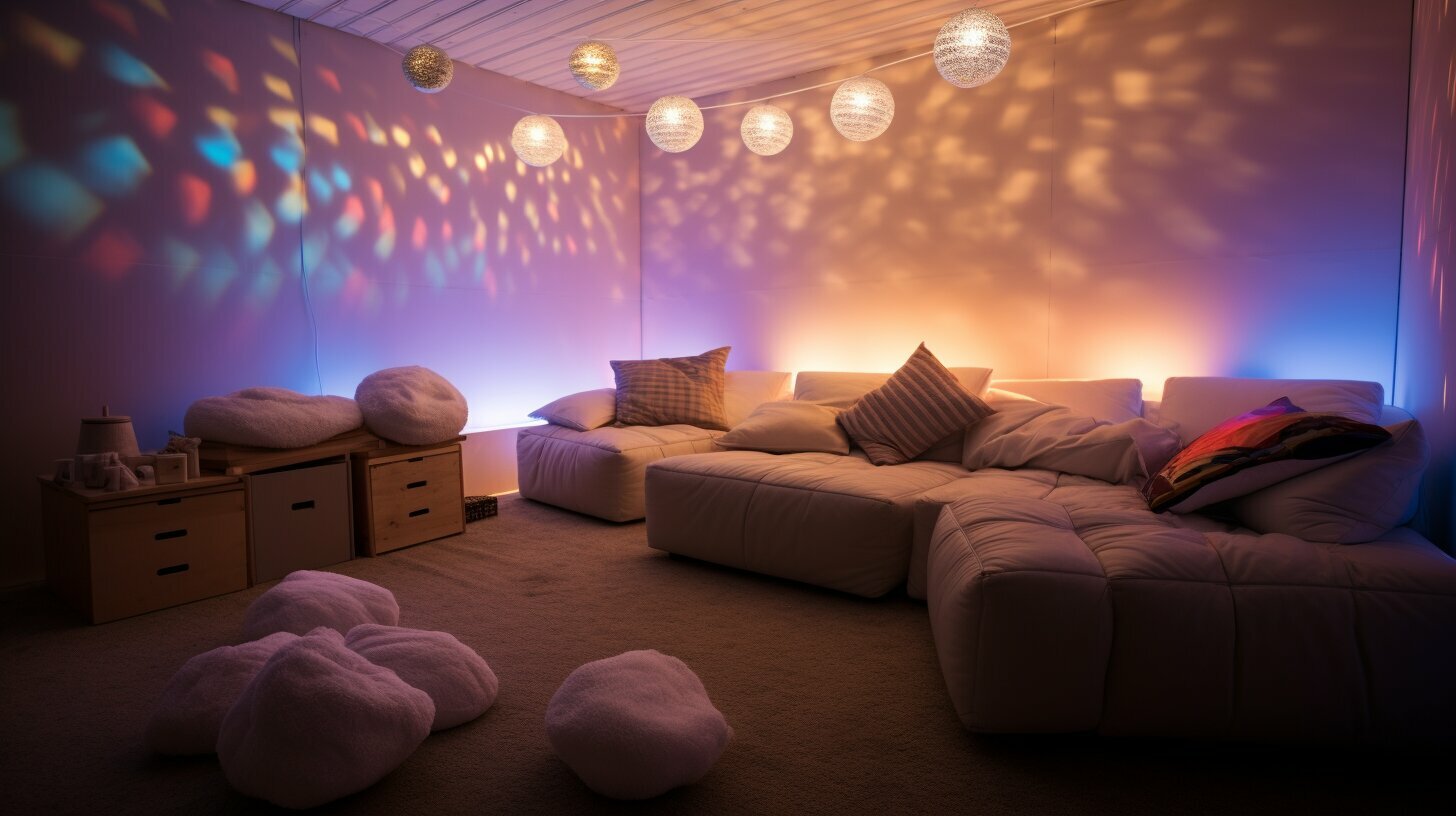It's crucial to know that students with autism and ADHD need special study strategies. Autism…

Explore What Is a Sensory Room: A Safe Haven for Exploration
If you’re unaware of what a sensory room is, it’s a specially designed space that provides a wide range of stimuli to individuals with sensory processing issues. Sensory rooms, also known as Multi-Sensory Environments (MSE), are designed to offer sensory input that is well-suited for individuals with autism, ADHD, or special needs.
The sensory room design is essential in providing a safe haven for exploration, relaxation, and therapy. Sensory rooms have a range of equipment, such as lights, textures, sounds, and a variety of visual aids, to provide an enriching and calming experience to its users. The purpose of sensory rooms is to offer a calming and therapeutic environment where individuals can explore and interact with different stimuli.
Understanding the Benefits of Sensory Rooms
If you or someone you know has autism, ADHD or is a special needs student, then you will understand the importance of a sensory room. This unique space is designed to provide a safe haven for exploration, relaxation, and therapeutic experiences. But, what are the benefits of sensory rooms? Let’s explore the advantages below.
Sensory Room for Autism:
Individuals with autism can often experience sensory overload, which can be overwhelming and distressing. Sensory rooms provide a calming and soothing environment, which can help reduce anxiety and stress levels. The use of sensory equipment such as fibre optic lights, interactive panels, weighted blankets and soft play areas can help individuals with autism to regulate and process sensory information effectively.
Sensory Room for ADHD:
Children with ADHD can benefit from the use of sensory rooms as it provides a space for them to channel their energy in a positive way. Sensory equipment such as trampolines, swings, and balance boards can help improve balance, coordination, and concentration. Additionally, the use of calming colours, aromatherapy diffusers, and soft lighting can help promote relaxation and reduce hyperactivity.
Sensory Room Design:
The design of a sensory room can have a significant impact on its therapeutic benefits. By prioritizing elements that support relaxation and reduce anxiety, individuals can feel more comfortable exploring their environment. This can involve creating a warm and calming atmosphere, using soft lighting and comfortable seating, and incorporating elements such as weighted blankets and pillows to provide a sense of security.
Additionally, the layout of a sensory room can play a key role in facilitating therapeutic experiences. By creating designated areas for different activities, individuals can develop a sense of structure and routine. This can involve using visual cues such as posters or pictures to help individuals understand what activities are available and how to engage with them.
Sensory Room Activities:
The activities available in a sensory room can provide a range of therapeutic benefits. Activities such as tactile play, interactive games, and music therapy can help individuals develop sensory processing skills, improve their communication and social skills, and reduce stress and anxiety.
It’s important to choose activities that are appropriate for individuals’ abilities and preferences. By providing a range of activities that cater to different interests, individuals can develop new skills and feel more engaged with their environment.
Sensory room activities can also be adapted to support individuals with specific needs. For example, individuals with autism may benefit from activities that focus on developing social skills, while individuals with ADHD may benefit from activities that promote relaxation and self-regulation.
Overall, by taking a strategic approach to sensory room design and incorporating appropriate activities, individuals can experience a range of therapeutic benefits. Whether it’s reducing stress and anxiety, improving sensory processing skills, or developing social and communication skills, a sensory room can be an essential tool for supporting individuals’ physical and mental wellbeing.
Sensory Room Equipment:
The equipment in a sensory room should be designed to cater to a range of sensory needs. Some equipment that may be useful in a sensory room includes:
| Equipment | Description |
|---|---|
| Bubble tubes | Provide visual stimulation and can also be used for calming |
| Ball pits | Provide tactile stimulation and can also be used for deep pressure calming |
| Swings | Provide vestibular stimulation and can also be calming |
| Sensory walls | Provide a range of tactile and visual stimulation |
When selecting equipment for your sensory room, consider how it can be used to encourage exploration and interaction. Ensure that the equipment is safe and appropriate for the individuals using the room.
Sensory Rooms for Therapeutic Benefits
When designing a sensory room, it’s important to focus on activities and equipment that contribute to a stimulating and engaging environment, but also take into consideration its therapeutic benefits. Taking the right approach to sensory room design can have a profound impact on an individual’s physical and mental wellbeing and facilitate the development of key skills.
Ultimately, the purpose of a sensory room is to provide a safe space where individuals can explore their senses at their own pace. By utilizing a range of sensory room activities, individuals can improve their ability to regulate their emotions, focus their attention, and develop their cognitive and motor skills.
Conclusion
Overall, sensory rooms offer a safe haven for exploration, relaxation, and therapeutic experiences. They are designed to provide individuals with a range of sensory experiences, helping to reduce stress and anxiety while promoting a sense of calmness and well-being.
If you are considering designing a sensory room, it is important to think carefully about the activities and equipment that will contribute to a stimulating and engaging environment. Keep in mind the specific needs and preferences of the individuals who will be using the room, as this will help to create a space that is truly tailored to their needs.
Whether you are using a sensory room for therapeutic purposes or simply as a space to relax and unwind, the benefits of these spaces are clear. By providing a safe, calming environment, sensory rooms can help to improve mood, reduce stress and anxiety, and promote overall well-being. So whether you are a parent, teacher, or therapist, consider incorporating a sensory room into your routine – and watch as the benefits begin to unfold.
Frequently Asked Questions
What is a sensory room?
A sensory room is a specially designed space that provides a safe and stimulating environment for individuals with sensory processing issues or disabilities. It is filled with sensory equipment and activities that engage the senses and promote relaxation, exploration, and therapeutic experiences.
How is a sensory room designed?
Sensory rooms are designed to be calming yet engaging environments. They typically include elements such as soft lighting, comfortable seating, padded flooring, and a variety of sensory equipment such as bubble tubes, tactile panels, and sound systems. The design aims to create a welcoming and inclusive space for individuals to explore their senses.
What is the purpose of a sensory room?
The purpose of a sensory room is to provide individuals with sensory processing issues or disabilities a safe haven for relaxation, exploration, and therapeutic experiences. It can help individuals regulate their sensory input, improve focus and attention, promote relaxation, reduce anxiety, and enhance overall well-being.
Who can benefit from a sensory room?
Sensory rooms are beneficial for individuals with various needs, including those with autism, ADHD, sensory processing disorder, and other special needs. They can also be useful for individuals who experience stress or sensory overload in their daily lives. The calming and interactive environment of a sensory room can benefit both children and adults.
What activities can be done in a sensory room?
Sensory rooms offer a wide range of activities that cater to individual needs. These can include sensory play with textured materials, visual stimulation with colour-changing lights or projectors, listening to calming music or nature sounds, engaging in gross motor activities like swinging or bouncing, or simply finding a quiet space for relaxation and reflection.
What equipment is typically found in a sensory room?
Common sensory room equipment includes bubble tubes, fibre optic lights, interactive panels, weighted blankets or vests, sensory swings, bean bags, and tactile materials like squishy toys or textured walls. The specific equipment may vary depending on the individual’s needs and the resources available in the sensory room.



This Post Has 0 Comments